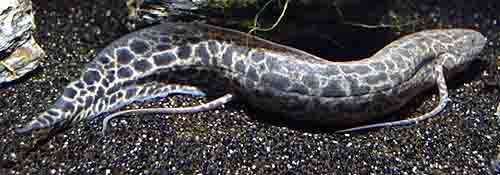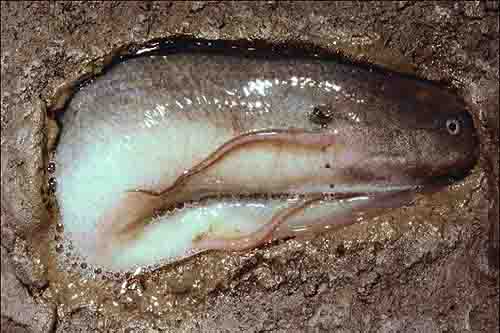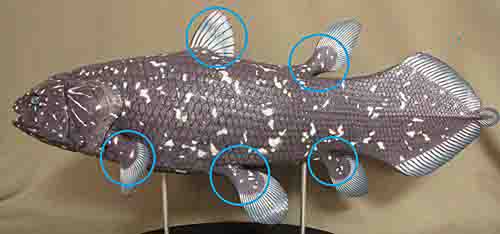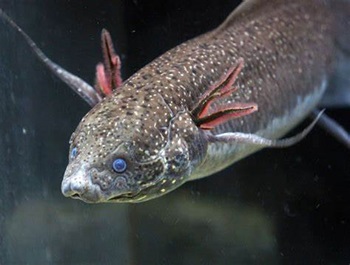Like other fish, lungfish have gills, but young fish develop lungs as they grow. As they grow, they become dependent on their lungs for oxygen uptake and must rise to the surface every few hours for a breather. If you are not careful, you may be targeted and eaten by large fish-eating birds.
肺魚は他の魚類と同様に鰓を持ちますが、幼体は成長に伴って肺が発達します。成長すると酸素の取り込みは肺に依存するようになり、数時間ごとに息継ぎで水面に上がる必要があります。その時に気お付けないと魚食性の大型鳥類に狙われ食べられてしまうことがあります。

Lungfish can estivate even when the water dries up.
Because lungfish do not depend on water for breathing, African lungfish will not die even if the water dries up during the dry season. This is because these lungfish can spend their time underground in a dormant state called “summer sleep” (estivate)until the next rainy season arrives. When the African lungfish goes into estivation it waits for the rainy season in a cocoon surrounded by a membrane of mucus and mud underground. There is a story that goes, “On a rainy day, a lungfish came out of the wall of an adobe house.”
肺魚は水が枯れても夏眠できる
肺魚は呼吸を水に依存しないため、アフリカ肺魚は乾期に水が干れても死ぬことはありません。この肺魚は次の雨期がくるまで地中で「夏眠」と呼ばれる休眠状態で過ごすことができるからです。アフリカハイギョが夏眠する時は、地中で粘液と泥からなる被膜に包まった繭の状態となり雨季を待ちます。それで「雨の日に、日干しレンガの家の壁からハイギョが出てきた」という話があります。

Lungfish and coelacanth are the same family.
Lungfish live in areas with dry seasons, and currently six species of lungfish have been confirmed to inhabit three continents: South America, Africa, and Australia. Lungfish have been around for 400 million years, and about 64 genera and 280 species, including freshwater and marine species, have been identified as fossil species. Lungfish were more prevalent in ancient times than they are today.
The shape of the fins of lungfish is similar to that of coelacanths, and they are called sarcoptera.
肺魚とシーラカンスは同じ仲間
肺魚は乾季がある地域に生息して、現在は南米、アフリカ、オーストラリアの3大陸に計6種の肺魚の生息が確認されています。肺魚は4億年前から生息していましたので化石種では淡水産・海水産を合わせると約64属280種が確認されています。肺魚は現在より古代の方が繁栄してことになります。
また肺魚は鰭の形からシーラカンスと同じ中間で、肉鰭類とよばれます。

硬骨魚は肉鰭類(にくきるい)と条鰭類(じょうきるい)の2系統あり、肺魚は肉鰭類に分類され、ハイギョはシーラカンス同じで仲間。肉鰭魚は魚の仲間でありながら、そのヒレ(鰭)が肉質になっている生物をまとめた呼び名です。

https://www.mitell-a.com/429/ coelacanths
eating habits
The teeth of lungfish are called dental plates. This is a combination of multiple teeth and jaw bones, and is strong enough to crush seashells. Lungfish have the unusual habit of chewing up their prey, taking it out of their mouths, and sucking it in with their saliva.
Lungfish mainly prey on animal matter such as frogs, snails, small fish, and shrimp. The tooth plates of lungfish are strong and easily remain in fossils, so some extinct species have only been described using their tooth plates. Although the lungfish has a somewhat enlarged esophagus, it does not have a well-developed stomach, so it chews its prey slowly.
食性
肺魚の歯は歯板と呼ばれます。これは複数の歯と顎の骨の結合したもので貝殻も砕く頑丈なものです。肺魚は獲物を噛み砕きながら口から出し、唾液とともに吸い込む変わった習性を持ちます。
肺魚はカエル、タニシ、小魚、エビなどの動物質を中心に捕食します。肺魚の歯板は頑丈で化石に残りやすいため、歯板のみで記載されている絶滅種もあります。ハイギョの食道には多少の膨大部はあるものの、発達した胃がないので、獲物をじっくりと噛み砕きます。

Although lungfish are living fossils, they can be kept as ornamentals and can live for approximately 10 to 20 years in captivity.
肺魚は生きた化石ですが観賞用として飼育することが可能で、飼育下ではおおよそ10年~20年も生きます。
魚類の分類
無顎類(むがくるい) ヤツメウナギ、サカバンバスピス
板皮類(ばんぴるい) ダンクルオステウス
棘魚類(きょくぎょるい) クリマウティウス
軟骨魚類(なんこつるい) サメ、エイ
硬骨魚類(こうこつ) 条鰭類(じょうきるい) マグロ、タイ
肉鰭類(にくきるい) シーラーカンス、肺魚

![[商品価格に関しましては、リンクが作成された時点と現時点で情報が変更されている場合がございます。] [商品価格に関しましては、リンクが作成された時点と現時点で情報が変更されている場合がございます。]](https://hbb.afl.rakuten.co.jp/hgb/349ffb18.8b2ef51f.349ffb19.97e7fe22/?me_id=1211165&item_id=10191202&pc=https%3A%2F%2Fthumbnail.image.rakuten.co.jp%2F%400_mall%2Fchanet%2Fcabinet%2F897%2F89588-1.jpg%3F_ex%3D300x300&s=300x300&t=picttext)




